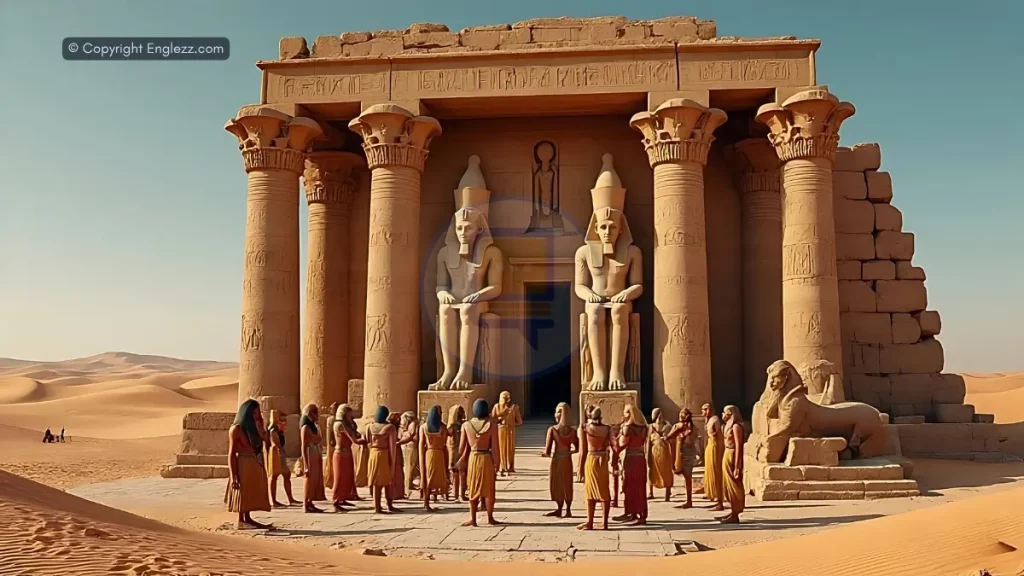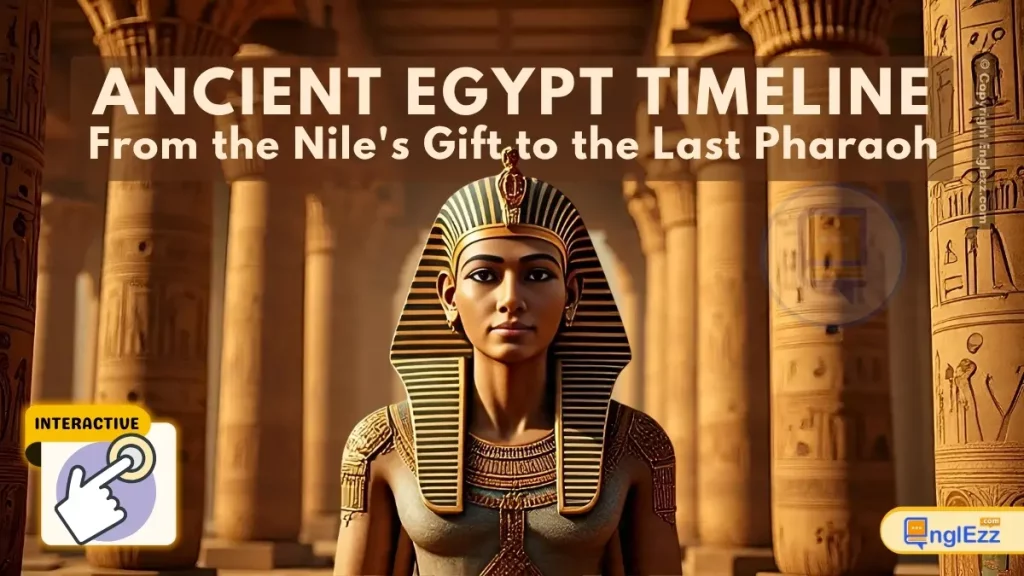
The Story of Ancient Egypt
From the Nile’s Gift to the Last Pharaoh
Introduction
The Egyptian Journey
The story of Ancient Egypt is one of the longest continuous histories of any civilization, spanning over 3,000 years along the fertile banks of the Nile River. This remarkable civilization developed one of the first centralized governments, sophisticated writing systems, and monumental architecture that still inspires awe today.
Ancient Egypt emerged from the Nile Valley’s agricultural potential, protected by deserts on either side. The predictable annual flooding of the Nile provided rich soil for crops, allowing the civilization to flourish. Through dynasties of pharaohs, periods of unity and fragmentation, conquest and independence, the Egyptians developed a complex society with advanced knowledge in mathematics, medicine, astronomy, and engineering.
This timeline explores key events and developments in Ancient Egyptian history, highlighting the political, social, religious, and cultural forces that shaped this enduring civilization. From the unification of Upper and Lower Egypt to the conquest by Alexander the Great, we trace the evolution of one of history’s most fascinating civilizations.
Early Dynastic Period
The Early Dynastic Period (c. 3100-2686 BCE) saw the unification of Upper and Lower Egypt under King Narmer (Menes), establishing the first dynasty. This period developed the foundations of Egyptian culture, including hieroglyphic writing, the solar calendar, and the concept of divine kingship. The capital at Memphis became the administrative center of the newly unified state.
Old Kingdom
The Old Kingdom (c. 2686-2181 BCE) was the “Age of the Pyramids,” when Egypt’s pharaohs demonstrated their absolute power by constructing monumental tombs. The Step Pyramid of Djoser, designed by Imhotep, and the Great Pyramids of Giza were built during this period. The Old Kingdom established many cultural and religious traditions that would endure throughout Egyptian history.
New Kingdom
The New Kingdom (c. 1550-1077 BCE) was Egypt’s imperial age, when it expanded its territory and reached the height of its power. Famous pharaohs like Hatshepsut, Thutmose III, Akhenaten, Tutankhamun, and Ramesses II ruled during this period. The Valley of the Kings became the royal burial site, and Egypt engaged in extensive trade and diplomacy with neighboring powers.
Explore the interactive Ancient Egypt timeline below to discover key events that shaped this civilization. Click on any event to learn more, and test your knowledge with our quiz when you’re ready!
Interactive Ancient Egypt Timeline
Unification of Egypt
King Narmer (Menes) unifies Upper and Lower Egypt, establishing the first dynasty and founding the capital at Memphis.
Read moreThe unification of Egypt under King Narmer (also known as Menes) marks the beginning of Egyptian civilization as a unified state. This event is commemorated on the Narmer Palette, one of the earliest historical documents, which depicts Narmer wearing the crowns of both Upper and Lower Egypt.
The unification brought together the Nile Valley (Upper Egypt) and the Nile Delta (Lower Egypt) under a single ruler. Narmer established the capital at Memphis, near modern Cairo, which would remain an important administrative and religious center throughout Egyptian history.
This period saw the development of many characteristic features of Egyptian civilization, including hieroglyphic writing, the solar calendar, and the concept of divine kingship. The pharaoh was seen as the earthly embodiment of the god Horus and responsible for maintaining ma’at (cosmic order).
The Early Dynastic Period laid the foundation for the Old Kingdom’s achievements, establishing the bureaucratic and cultural systems that would allow Egypt to flourish for millennia.
Further Reading
- Wilkinson, Toby. Early Dynastic Egypt (1999)
- Shaw, Ian. The Oxford History of Ancient Egypt (2000)
Reign of Djoser
Pharaoh Djoser commissions the Step Pyramid at Saqqara, designed by his vizier Imhotep, the first monumental stone building in Egypt.
Read moreDjoser, the second king of the 3rd Dynasty, ruled during a period of remarkable architectural innovation. His vizier Imhotep, a polymath who would later be deified, designed the Step Pyramid complex at Saqqara, which represents the transition from mastaba tombs to true pyramids.
The Step Pyramid stands 62 meters tall and consists of six mastaba-like layers decreasing in size upward. The complex included a mortuary temple, courtyards, shrines, and a boundary wall, all designed to serve the pharaoh in the afterlife. This was the first large-scale stone construction in Egypt and set the precedent for later pyramid building.
Djoser’s reign also saw administrative reforms that strengthened central authority and expanded Egypt’s influence into Nubia and the Sinai. The stability and prosperity of his rule allowed for such monumental construction projects.
Imhotep’s architectural innovations and his reputation as a sage led to his later worship as a god of medicine and wisdom, a rare honor for a non-royal individual in Egyptian history.
Further Reading
- Lehner, Mark. The Complete Pyramids (1997)
- Verner, Miroslav. The Pyramids: The Mystery, Culture, and Science of Egypt’s Great Monuments (2001)
Great Pyramid of Giza
Pharaoh Khufu builds the Great Pyramid at Giza, the largest of the Egyptian pyramids and one of the Seven Wonders of the Ancient World.
Read moreThe Great Pyramid of Giza, built for Pharaoh Khufu (Cheops) of the 4th Dynasty, represents the pinnacle of Old Kingdom pyramid construction. Originally standing 146.6 meters tall (now 138.8 due to erosion), it was the tallest man-made structure in the world for over 3,800 years.
The pyramid contains an estimated 2.3 million stone blocks, each weighing an average of 2.5 tons, with some weighing up to 80 tons. The precision of its construction is remarkable – the sides are aligned almost perfectly with the cardinal directions, and the base is level to within 2.1 cm.
The pyramid complex included two mortuary temples, three smaller pyramids for queens, a causeway, and a valley temple. The pyramid’s interior contains three chambers: the King’s Chamber, the Queen’s Chamber, and an unfinished subterranean chamber.
Recent discoveries suggest that a large workforce of skilled laborers (not slaves, as once thought) built the pyramid, housed in a nearby workers’ village. The pyramid’s construction demonstrates the pharaoh’s absolute power and the administrative capabilities of the Old Kingdom state.
Further Reading
- Lehner, Mark. The Complete Pyramids (1997)
- Hawass, Zahi. Mountains of the Pharaohs: The Untold Story of the Pyramid Builders (2006)
Middle Kingdom Flourishes
The Middle Kingdom period sees a renaissance in art, literature, and expansion of Egyptian influence under pharaohs like Mentuhotep II and Amenemhat III.
Read moreThe Middle Kingdom (11th-13th Dynasties) began when Mentuhotep II reunited Egypt after the First Intermediate Period, establishing the 11th Dynasty with its capital at Thebes. This period is often called Egypt’s “classical age” due to its artistic and literary achievements.
Middle Kingdom pharaohs focused on strengthening Egypt’s borders, building fortresses in Nubia, and expanding trade with the Levant and Punt. The Faiyum region was developed through extensive irrigation projects under Amenemhat III, who also built the last great pyramid complex at Hawara.
This period produced some of Egypt’s finest literature, including the “Story of Sinuhe,” “Instructions of Amenemhat,” and “The Eloquent Peasant.” Art became more expressive, with realistic portraits of pharaohs showing human emotion rather than idealized forms.
The Middle Kingdom declined due to weak later rulers, culminating in the Second Intermediate Period when the Hyksos, a Semitic people from the Levant, took control of northern Egypt.
Further Reading
- Grajetzki, Wolfram. The Middle Kingdom of Ancient Egypt (2006)
- Simpson, William Kelly. The Literature of Ancient Egypt (2003)
Reign of Hatshepsut
Hatshepsut, one of Egypt’s few female pharaohs, rules as regent then pharaoh, commissioning impressive building projects and trade expeditions.
Read moreHatshepsut, daughter of Thutmose I and wife of Thutmose II, initially ruled as regent for her stepson Thutmose III but eventually took the full titles of pharaoh. She legitimized her rule by claiming divine birth and often depicted herself in male attire with a false beard.
Her reign was marked by peace and prosperity. She restored trade networks disrupted during Hyksos rule, sending a famous expedition to Punt (likely modern Somalia) that returned with gold, ivory, exotic animals, and incense trees. These were depicted in reliefs at her mortuary temple at Deir el-Bahari.
Hatshepsut was one of Egypt’s most prolific builders, commissioning hundreds of construction projects throughout Egypt. Her mortuary temple at Deir el-Bahari is considered an architectural masterpiece, with colonnaded terraces rising from the desert floor into the cliffs.
After her death, Thutmose III attempted to erase her memory, defacing her monuments and removing her name from king lists. Modern archaeology has restored her place as one of Egypt’s most successful rulers.
Further Reading
- Cooney, Kara. The Woman Who Would Be King: Hatshepsut’s Rise to Power in Ancient Egypt (2014)
- Tyldesley, Joyce. Hatchepsut: The Female Pharaoh (1996)
Akhenaten’s Religious Revolution
Pharaoh Akhenaten introduces monotheistic worship of the Aten, moves the capital to Amarna, and transforms Egyptian art and religion.
Read moreAkhenaten, originally Amenhotep IV, instituted one of the most radical religious revolutions in ancient history. He abandoned traditional Egyptian polytheism, especially the worship of Amun, in favor of exclusive devotion to the sun disk Aten.
In year 5 of his reign, Akhenaten founded a new capital at Akhetaten (modern Amarna) in Middle Egypt, far from the traditional religious centers. The Amarna style of art that developed there broke from tradition, depicting the royal family with elongated faces, heavy hips, and intimate family scenes never before shown in Egyptian art.
Akhenaten’s religious reforms were unpopular with both the priesthood and common people. After his death, his successors, including Tutankhamun, restored traditional religion. Akhenaten’s monuments were dismantled, and his name was omitted from official king lists, making him the “heretic king” of Egyptian history.
The Amarna period produced beautiful art and poetry, including the “Great Hymn to the Aten,” which bears similarities to Psalm 104. The period provides valuable insights into Egyptian religion, art, and politics when traditional norms were temporarily suspended.
Further Reading
- Montserrat, Dominic. Akhenaten: History, Fantasy and Ancient Egypt (2000)
- Redford, Donald B. Akhenaten: The Heretic King (1984)
Reign of Ramesses II
Ramesses II, one of Egypt’s most powerful pharaohs, rules for 66 years, building monumental structures and fighting the Hittites at Kadesh.
Read moreRamesses II, also known as Ramesses the Great, was the third pharaoh of the 19th Dynasty. His 66-year reign was the second longest in Egyptian history and marked the peak of Egypt’s imperial power.
Ramesses is famous for his military campaigns, particularly the Battle of Kadesh (1274 BCE) against the Hittites, which ended in a stalemate but was commemorated as a great victory in temple reliefs throughout Egypt. The conflict concluded with history’s first recorded peace treaty between Ramesses and Hittite king Hattusili III.
A prolific builder, Ramesses constructed more monuments than any other pharaoh, including the Ramesseum (his mortuary temple), the rock temples at Abu Simbel, and additions to nearly every major temple in Egypt. He moved the capital to Pi-Ramesses in the Nile Delta.
Ramesses outlived many of his children and died in his 90s. His mummy, discovered in 1881, shows he suffered from arthritis and dental problems in old age. His long reign and numerous monuments made him one of Egypt’s most remembered pharaohs.
Further Reading
- Tyldesley, Joyce. Ramesses: Egypt’s Greatest Pharaoh (2000)
- Kitchen, K.A. Pharaoh Triumphant: The Life and Times of Ramesses II (1982)
Persian Conquest
Cambyses II of Persia conquers Egypt, establishing the 27th Dynasty and making Egypt a satrapy (province) of the Achaemenid Empire.
Read moreThe Persian conquest ended Egypt’s 26th Dynasty and native rule (except for brief periods) until the 20th century. Cambyses II defeated Pharaoh Psamtik III at the Battle of Pelusium, allegedly by using cats and other sacred animals as shields to exploit Egyptian religious scruples.
Persian rule was generally tolerant of Egyptian religion and customs, though heavy taxation and the imposition of foreign rulers caused resentment. The Persians used Egypt as a base for campaigns against Carthage and Ethiopia, though these were unsuccessful.
Egyptian revolts in 487 BCE and 460 BCE were brutally suppressed. The latter, supported by Athens during the First Peloponnesian War, lasted six years before being defeated. Persian rule continued until 404 BCE when Amyrtaios rebelled successfully, establishing the short-lived 28th Dynasty.
The Persians would reconquer Egypt in 343 BCE, ruling until Alexander the Great’s arrival in 332 BCE. This second period of Persian rule (31st Dynasty) was harsher, with temples plundered and sacred animals killed, creating a lasting negative memory of Persian rule in Egyptian tradition.
Further Reading
- Lloyd, Alan B. From the Twenty-sixth to the Thirty-first Dynasty (2000)
- Briant, Pierre. From Cyrus to Alexander: A History of the Persian Empire (2002)
Alexander the Great Conquers Egypt
Alexander the Great liberates Egypt from Persian rule, is declared pharaoh, and founds the city of Alexandria.
Read moreAfter defeating the Persians at the Battle of Issus (333 BCE), Alexander entered Egypt in 332 BCE, where he was welcomed as a liberator from oppressive Persian rule. The Persian satrap Mazaces surrendered without a fight.
Alexander traveled to the Siwa Oasis, where the oracle of Amun reportedly confirmed his divine status as the son of Amun (whom Alexander associated with Zeus). This legitimized his rule as pharaoh in Egyptian eyes.
He founded Alexandria on the Mediterranean coast, which would become one of the ancient world’s greatest cities and Egypt’s capital for nearly a thousand years. The city’s design by Deinocrates featured wide streets in a grid pattern and was renowned for its lighthouse (Pharos) and library.
Alexander left Egypt in 331 BCE to continue his conquest of the Persian Empire, never to return. After his death in 323 BCE, his general Ptolemy established the Ptolemaic Dynasty that would rule Egypt for nearly 300 years.
Further Reading
- Bosworth, A.B. Conquest and Empire: The Reign of Alexander the Great (1988)
- Green, Peter. Alexander of Macedon, 356-323 B.C.: A Historical Biography (1991)
Death of Cleopatra VII
Cleopatra VII, the last active ruler of Ptolemaic Egypt, dies by suicide, marking the end of Pharaonic Egypt and the beginning of Roman rule.
Read moreCleopatra VII, the last of the Ptolemaic rulers, attempted to maintain Egypt’s independence amid Rome’s growing power. She famously allied with Julius Caesar, bearing him a son (Caesarion), and later with Mark Antony, with whom she had three children.
After Octavian (later Augustus) defeated Antony and Cleopatra at the Battle of Actium (31 BCE), the couple retreated to Alexandria. Facing inevitable defeat, Antony committed suicide, and Cleopatra followed suit on August 12, 30 BCE, traditionally by the bite of an asp (Egyptian cobra).
With Cleopatra’s death, Egypt became a Roman province, ending nearly 3,000 years of native rule. Her son Caesarion was executed, and Egypt became Rome’s breadbasket, remaining under Roman (later Byzantine) control until the Arab conquest in 641 CE.
Cleopatra’s life has been romanticized in literature and art, from Shakespeare’s play to Hollywood films. Modern scholarship recognizes her as a skilled politician and diplomat who spoke multiple languages and was the first Ptolemaic ruler to learn Egyptian.
Further Reading
- Tyldesley, Joyce. Cleopatra: Last Queen of Egypt (2008)
- Roller, Duane W. Cleopatra: A Biography (2010)
Ancient Egypt Civilization Quiz
Test Your Knowledge of Ancient Egypt
Frequently Asked Questions
Common Questions About Ancient Egypt
The construction of the pyramids remains one of ancient Egypt’s most impressive achievements. While no single method has been definitively proven, archaeologists have developed several plausible theories based on evidence:
- Workforce: Contrary to popular belief, the pyramids were built by skilled laborers, not slaves. Workers were likely farmers who worked during the Nile’s annual flood when agricultural work was impossible.
- Ramps: Various ramp systems may have been used to drag stone blocks into position. These could have been straight ramps, zigzagging ramps, or internal spiral ramps.
- Quarrying: Limestone blocks were quarried nearby using copper chisels and wooden wedges. Granite for interior chambers came from Aswan, hundreds of miles away.
- Transport: Blocks were likely moved on sleds over wet sand to reduce friction, as depicted in tomb paintings.
- Precision: The Great Pyramid’s sides are aligned almost perfectly with the cardinal directions, achieved through astronomical observations.
The entire process required sophisticated administration to organize workers, materials, and food supplies for the large workforce.
Mummification was central to ancient Egyptian beliefs about the afterlife. The Egyptians believed that preserving the body was essential for the soul’s survival in the afterlife. Key aspects include:
- Religious Belief: The ka (life force) and ba (personality) needed a preserved body to return to. Without it, the deceased could not achieve eternal life.
- Process: The 70-day process involved removing internal organs (stored in canopic jars), dehydrating the body with natron salt, and wrapping it in linen bandages.
- Organs: The brain was discarded (considered unimportant), but the heart was left in place as the center of intelligence and emotion.
- Development: Early burials in sand naturally preserved bodies. As tombs became more elaborate, artificial mummification developed to maintain preservation.
- Social Status: Full mummification was expensive. Poorer people received simpler treatments, while animals were also mummified as offerings to gods.
The best-preserved mummies date from the New Kingdom, showing the peak of Egyptian embalming skills.
The Rosetta Stone, discovered in 1799, was crucial for deciphering Egyptian hieroglyphs because it contained the same text in three scripts:
- Three Scripts: The stone bears a decree from 196 BCE written in hieroglyphs (used for religious texts), Demotic (everyday Egyptian script), and Ancient Greek (the administrative language under the Ptolemies).
- Decipherment: Scholars could read Ancient Greek, allowing them to match the Greek text to the Egyptian scripts. Jean-François Champollion made the final breakthrough in 1822 by identifying that hieroglyphs represented sounds (phonograms) as well as ideas (ideograms).
- Impact: The decipherment opened up thousands of years of Egyptian history recorded in hieroglyphs, revolutionizing Egyptology. For the first time, scholars could read original Egyptian texts rather than relying on Greek or Roman accounts.
- Content: The stone itself records a decree affirming the royal cult of Ptolemy V, showing how Greek rulers sought Egyptian priestly support.
The Rosetta Stone remains one of the most important archaeological discoveries, now housed in the British Museum.
Daily life varied by social class but was largely shaped by the Nile’s rhythms and religious beliefs:
- Agriculture: Most Egyptians were farmers, growing wheat, barley, flax, and vegetables. The Nile’s annual flood (July-October) determined the agricultural cycle.
- Homes: Houses were made of mudbrick, with wealthier homes having multiple rooms, courtyards, and wall paintings. Furniture was simple – stools, beds, and chests.
- Food: The diet included bread, beer, vegetables (onions, garlic, lentils), fish, and occasionally meat (beef, poultry). Fruits included dates, figs, and grapes.
- Clothing: Linen made from flax was the primary fabric. Men wore kilts, women wore straight dresses. Both sexes used makeup (kohl for eyes) and wore wigs or styled their hair.
- Work: Besides farming, Egyptians worked as craftsmen, scribes, priests, soldiers, and officials. Specialized jobs included pyramid builders, embalmers, and goldsmiths.
- Entertainment: People enjoyed music, dancing, board games (like Senet), and festivals honoring gods. Hunting and fishing were both practical and recreational.
Social hierarchy was rigid but allowed some mobility, especially through military or scribal service.
Conclusion
The Legacy of Ancient Egypt
Ancient Egypt’s civilization endured for over three millennia, leaving an indelible mark on world history. From the first pyramids to the last Ptolemaic ruler, Egypt developed sophisticated systems of government, religion, art, and architecture that continue to fascinate us today.
The longevity of Egyptian culture is remarkable, maintaining core traditions while adapting to changing circumstances. Even under foreign rule, Egyptian religion, art forms, and bureaucratic systems persisted, testifying to the civilization’s resilience and appeal.
Ancient Egypt Key Takeaways
Early Foundations
The Early Dynastic Period established Egypt as a unified state with hieroglyphic writing, divine kingship, and monumental architecture.
Pyramid Age
The Old Kingdom saw the construction of Egypt’s most iconic monuments, demonstrating the pharaohs’ absolute power and organizational capabilities.
Cultural Renaissance
The Middle Kingdom was Egypt’s classical age, producing refined literature and art while expanding trade and territory.
Imperial Power
The New Kingdom marked Egypt’s imperial height, with famous pharaohs like Hatshepsut, Akhenaten, and Ramesses II ruling a vast empire.
Foreign Rule
The Late Period saw alternating native and foreign rulers as Egypt’s independence gradually eroded before Persian conquest.
Hellenistic Egypt
The Ptolemaic Period blended Egyptian and Greek culture, ending with Cleopatra’s dramatic reign and Roman conquest.
Ancient Egypt’s achievements in engineering, medicine, astronomy, and art set standards that influenced neighboring civilizations. The decipherment of hieroglyphs in the 19th century opened a window into this remarkable culture, allowing us to appreciate its complexity and continuity across millennia.
Recommended Reading About Ancient Egypt
- Shaw, Ian. The Oxford History of Ancient Egypt (2000)
- Wilkinson, Toby. The Rise and Fall of Ancient Egypt (2010)
- Tyldesley, Joyce. Chronicle of the Queens of Egypt (2006)
- Lehner, Mark. The Complete Pyramids (1997)
- Hornung, Erik. Conceptions of God in Ancient Egypt (1982)









